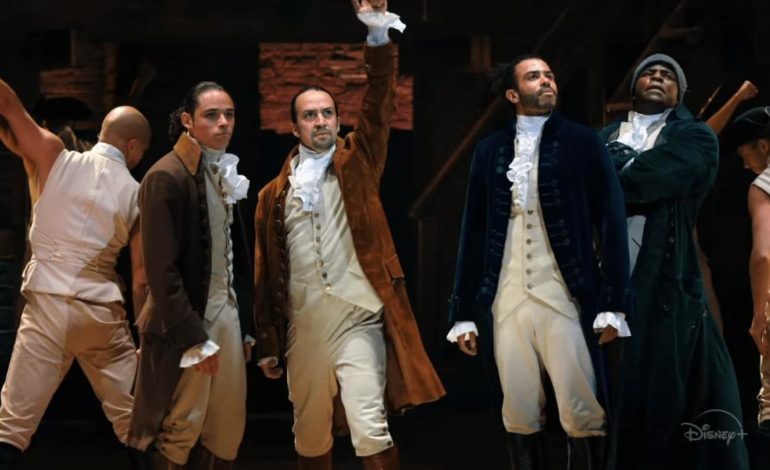

Let’s talk about the music in Hamilton. It’s no secret that Lin-Manuel Miranda is a huge musical theatre fan. Being a musical theatre fan myself, I had a hard time keeping track of all the musical theatre Easter eggs that Miranda hid in his musical. So far, after my fourth or fifth watch of the film, I have counted references to at least 10 musicals, plays, and operas. When he is not lyrically referencing another musical or play, he is doing it in the melody. When Burr sings, “I look back on where I failed,” it is the same melody as “I am reaching, but I fall” in Les Miserables. In the song “You’ll Be Back,” the notes do the opposite the words are describing like in the song “Spoonful of Sugar.” Besides referencing musical theatre that came before him, he also references hip-hop artists like 50 Cent, Eminem, Mobb Deep, and Biggie, to name a few.
When the film opens the first song “Alexander Hamilton,” the tempo is at a normal pace as his story is being told. Hamilton is introduced, and he focuses on his education. When he makes that he way out of the Caribbean, the tempo doubles in speed. At a “normal” pace, this would be a four – six-hour production. Because of Miranda’s revolutionary music and the talents of Daveed Diggs and Renee Elise Goldsberry, the production is cut to two-and-a-half hours. The fastest verse in “Satisfied,” Goldsberry sings 121 words in 24 seconds; the fasted verse in “Guns and Ships” is 19 words in three seconds.
Each character performs in a different style, which is more telling about the character. George Washington raps is a metronomic way, which is like how he thinks. He is always rapping right on the beat. Lafayette’s rapping grows from a simple 80s style to rapping in double and triple time. Similarly, Jefferson’s style also develops. In his first song is in a jazz style; he was away from the US, and he is behind the times. Soon he grows to have rap battles with Hamilton. Burr is unchanging in his musical style. He repeats the same words or the same ideas when he introduces a new scene to the audience. King George sings in an entirely different musical style than any other one performed in the show. His songs have a 60s vibe, reminiscent of The Beatles. Since the style is so different from the rest of the show, his presence and his music don’t fit. The rest of the cast is evolving and changing, while the King is stuck in the past. His song “You’ll Be Back” even has a harpsichord for about 45 seconds, which is another example of King George being stuck in the past.


Digging deeper into musical theory, the personalities of Hamilton and Burr are clear. Even if we know nothing else, the music itself can tell us a lot about them. Aaron Burr’s chord progression is (I, vi, iii). Without getting too technical, ending a chord progression like this is telling us musically that Burr is stuck and has nowhere to go. His career is stagnant, and it adds a lot more weight to the song “Wait For It.” Burr is literally waiting on second base while Hamilton is stealing bases and hitting home runs. Hamilton’s chord progression is (i, III, iv, VI, V) a more complete progression with a turnaround and ambitious. Like his personality and ambition, the music drives his narrative forward. This progression can be heard in “My Shot” and “Satisfied.” When Burr reveals that he wants to be in the room where it happens, underneath, we hear “My Shot” being sung by the chorus. Burr finally taking a step towards what he wants is an action, which is why we hear Hamilton’s chord progression and not Burr’s.
Knowing a show backward and forwards can set many expectations when you finally get to see it. It pleased me to discover there were some surprises to those of us that only heard the cast album. The last two minutes of the credits a melody of the Hamilton music plays. They usually perform this music as people leave the theatre after the show. It was nice to hear the exit music since they do not include it on the cast album. Another song not on the album is the scene when Eliza reads the letter from John Laurens’s father, informing Hamilton of his son’s death.
One thing that Les Miserables did wrong was how they performed the songs live. It seemed they were only interested in the acting aspect and not so much the singing element. Anne Hathaway did an incredible acting performance as Fantine, but her singing performance limited because of all of her crying. In contrast, the actors in Hamilton looked like they were crying without crying. This way, they could preserve their voices without all the mucus from crying. Anthony Ramos could sing, maintain breath support, and control his voice, all while lying down. Christopher Jackson, Lin-Manuel Miranda, Leslie Odom Jr, and Phillipa Soo gave robust, goosebump, hair stand up performances. There were actual tears, and at times they were acting. Each time at my house, actual tears were flowing.


Finally, I enjoyed the limited use of the fourth wall break. Burr addresses the audience directly, but I feel it is more in a Greek chorus kind of way. George Washington breaks the fourth wall during the cabinet meetings. He addresses the audience directly and has them cheer on Jefferson and Hamilton. The ending is absolute perfection. Burr steps aside, and Eliza becomes the narrator for the end of the show. There has been some debate on what her gasp before the stage goes black was. To me, Eliza is becoming overwhelmed by emotion in a fourth wall break. She is seeing the audience watching the story about her husband and is happy that his story wasn’t only being told but not forgotten.
